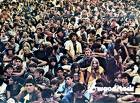
The network can’t congregate in a single physical location. Compare and contrast to Woodstock, or the gatherings of the 60s. It’s a limit of the current 802.11 wireless network technology. Perhaps no one anticipated that everyone would be able to and want to connect. And many people want to connect both with their laptops and their phones.
Given the current models, the physics of the event dictate that as the particles converge on a location, the network pipes clog to the point of stillness. The mass of people can talk to each other, but they can’t broadcast to the network.
Live blogging and Twitter have moved beyond the technology conference into both our politics and our lives. The Democratic Convention in Denver will feature a blogger assigned to each of the delegations. As we attempt to broadcast our politics into the network, in the interest of full and open disclosure, we’ll find we occupy a black hole. The density of the particles will prevent any light from escaping.
Of course, we’ll find a way to get reports out. Twitter, with its minimal requirements and multiple network paths, may be the most usable live reporting tool. The pulse of our politics could be largely expressed in bursts of 140 character SMS messages.
Comments closed

